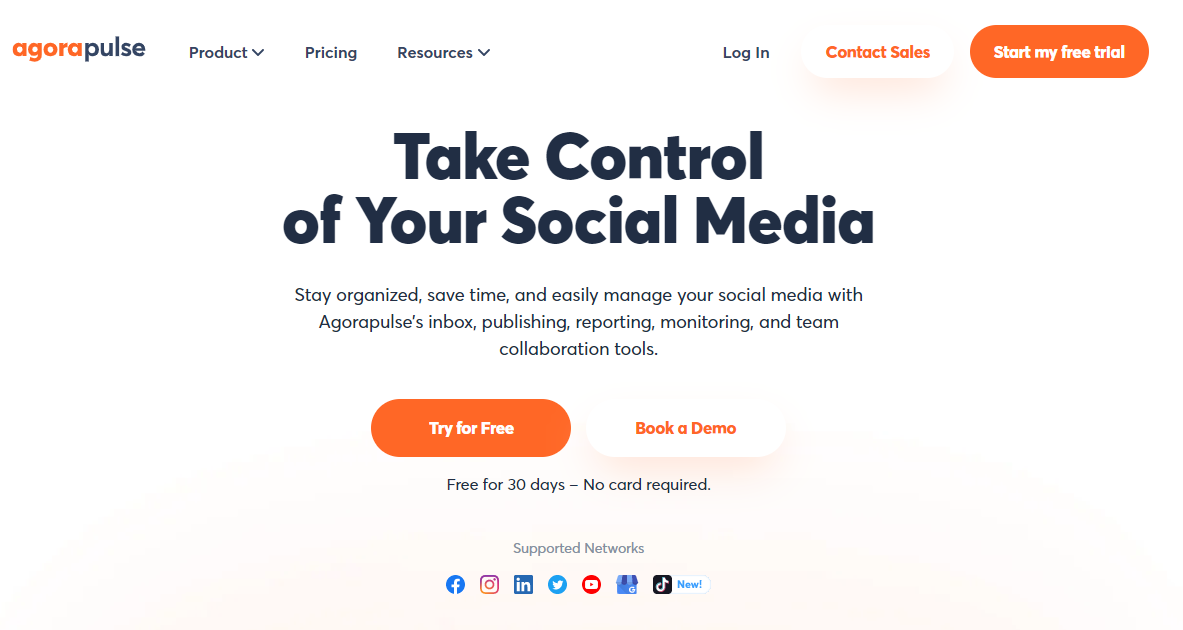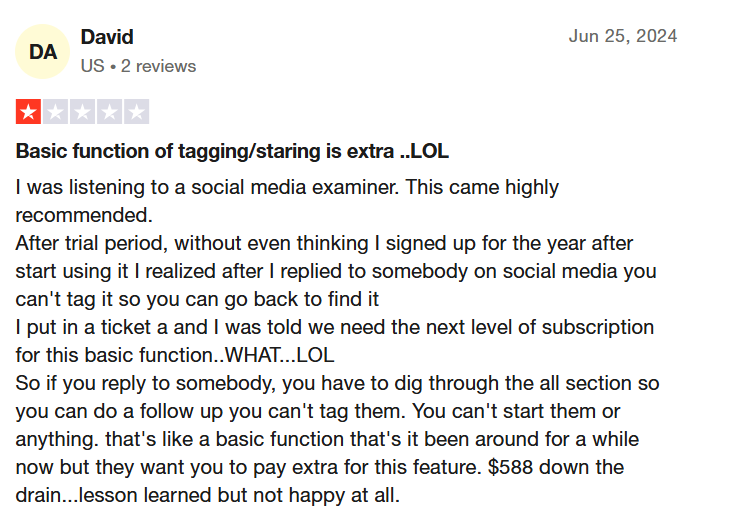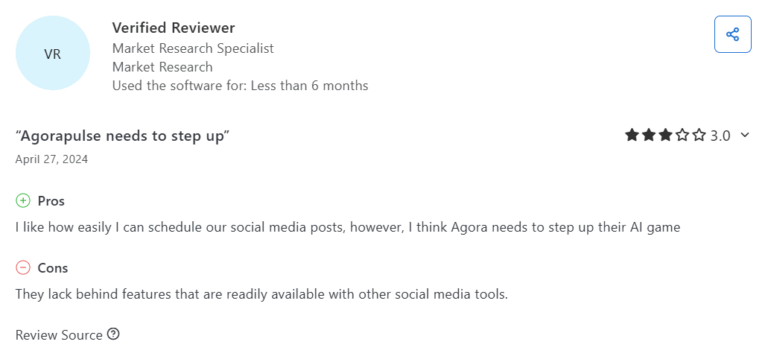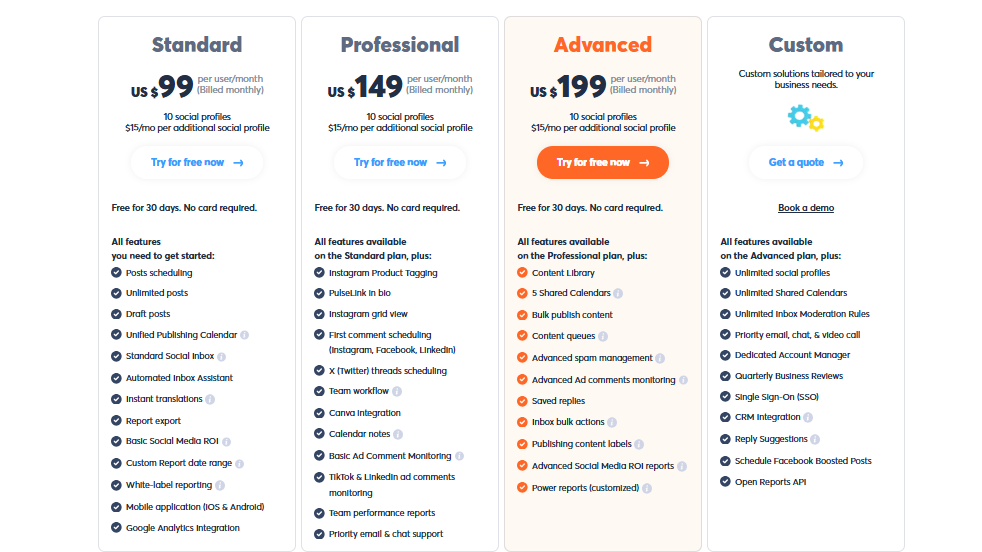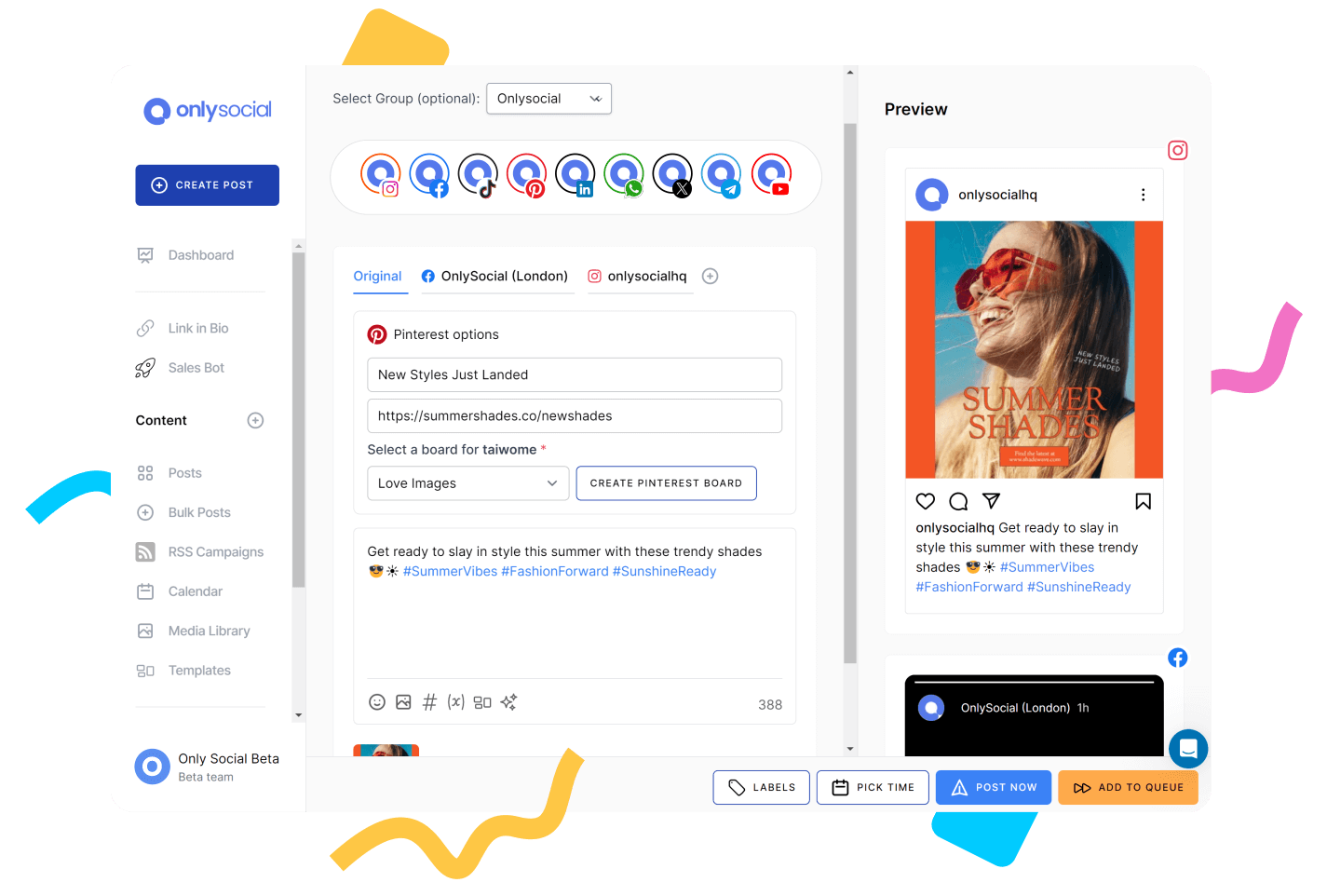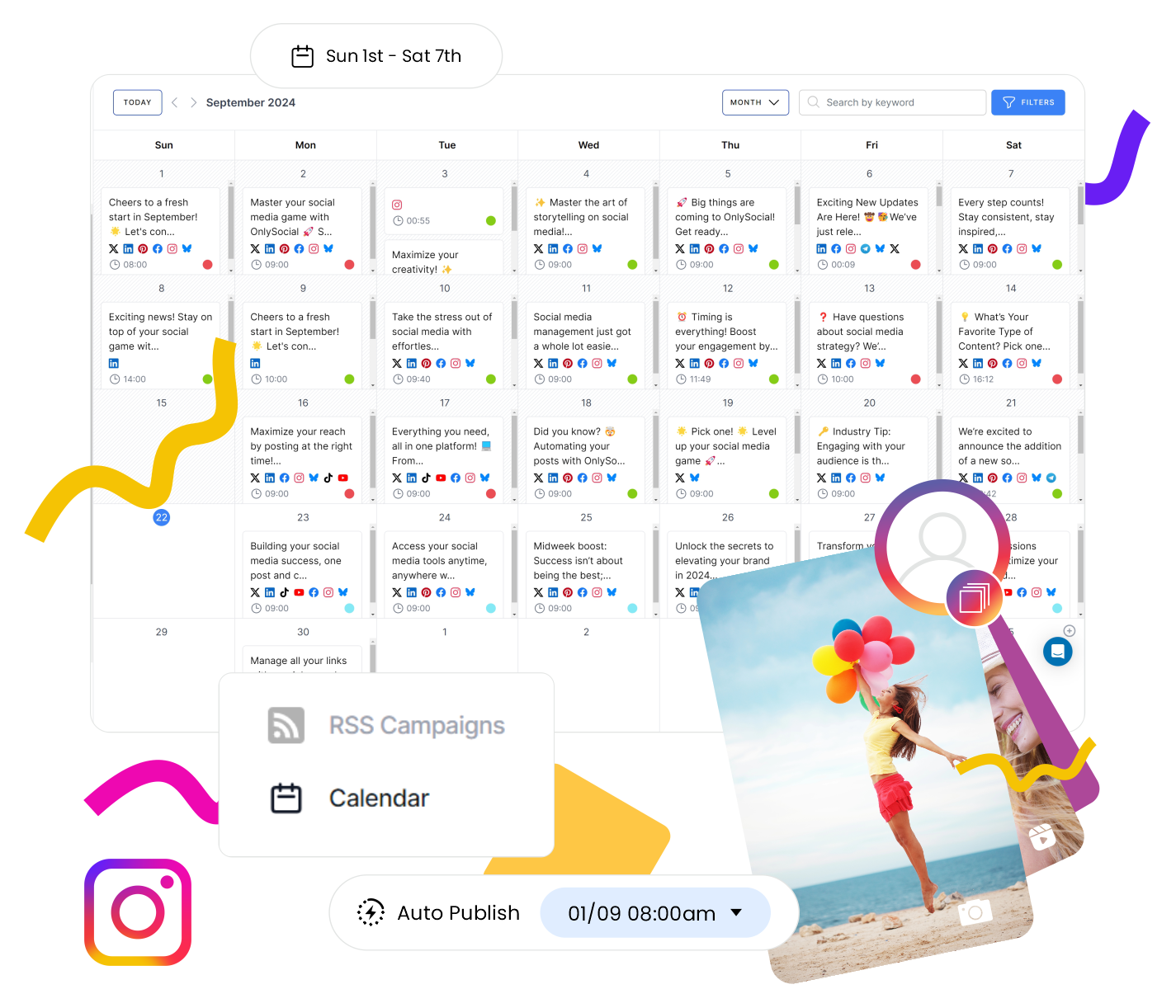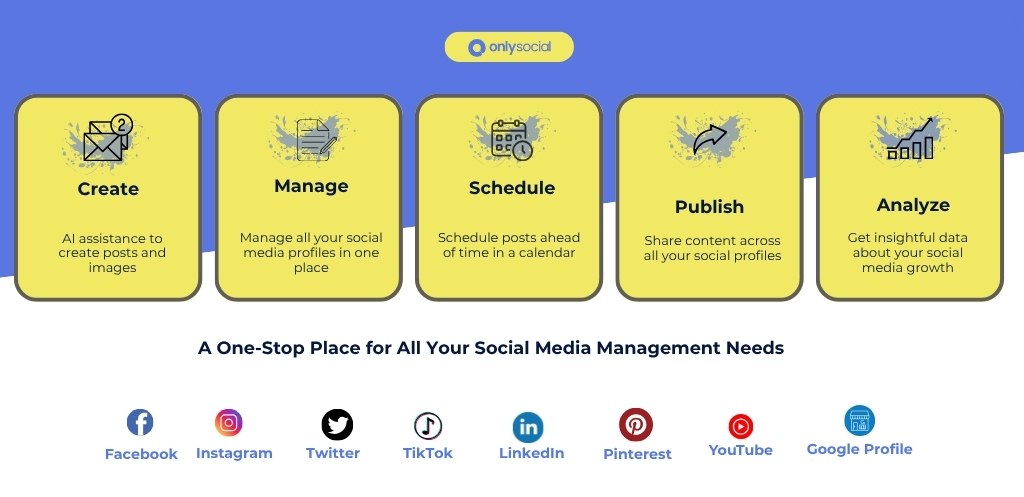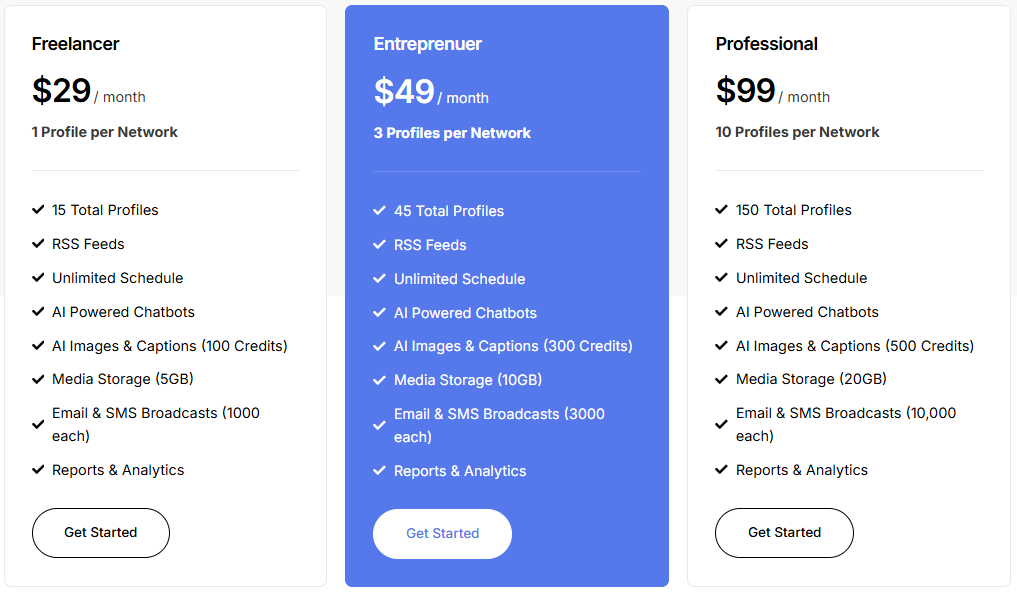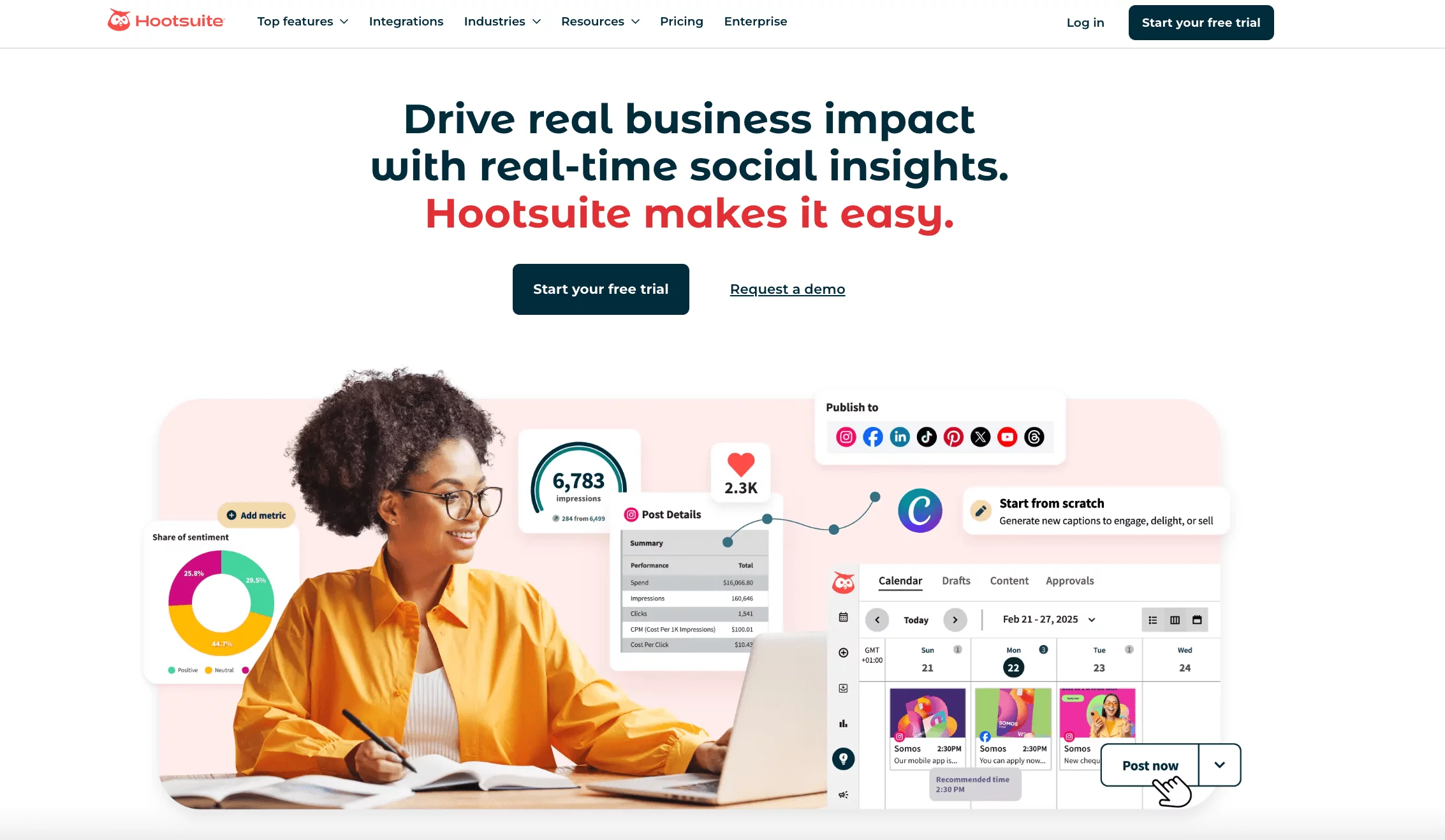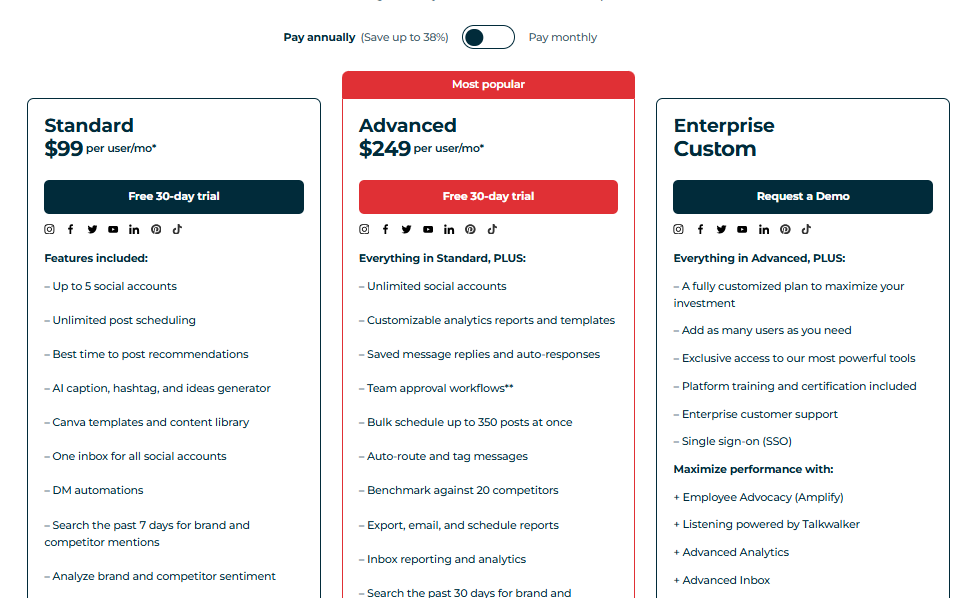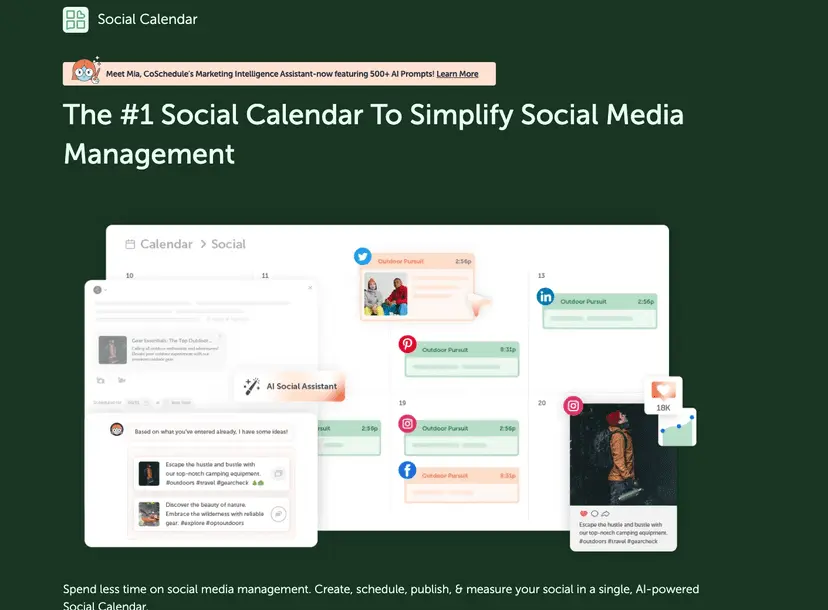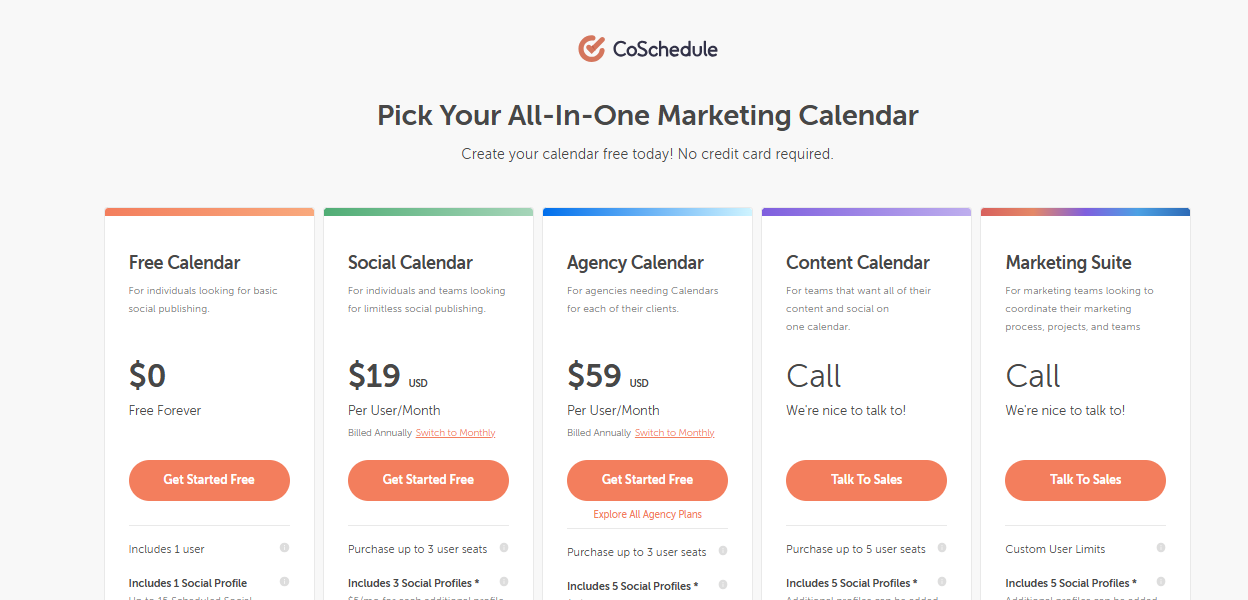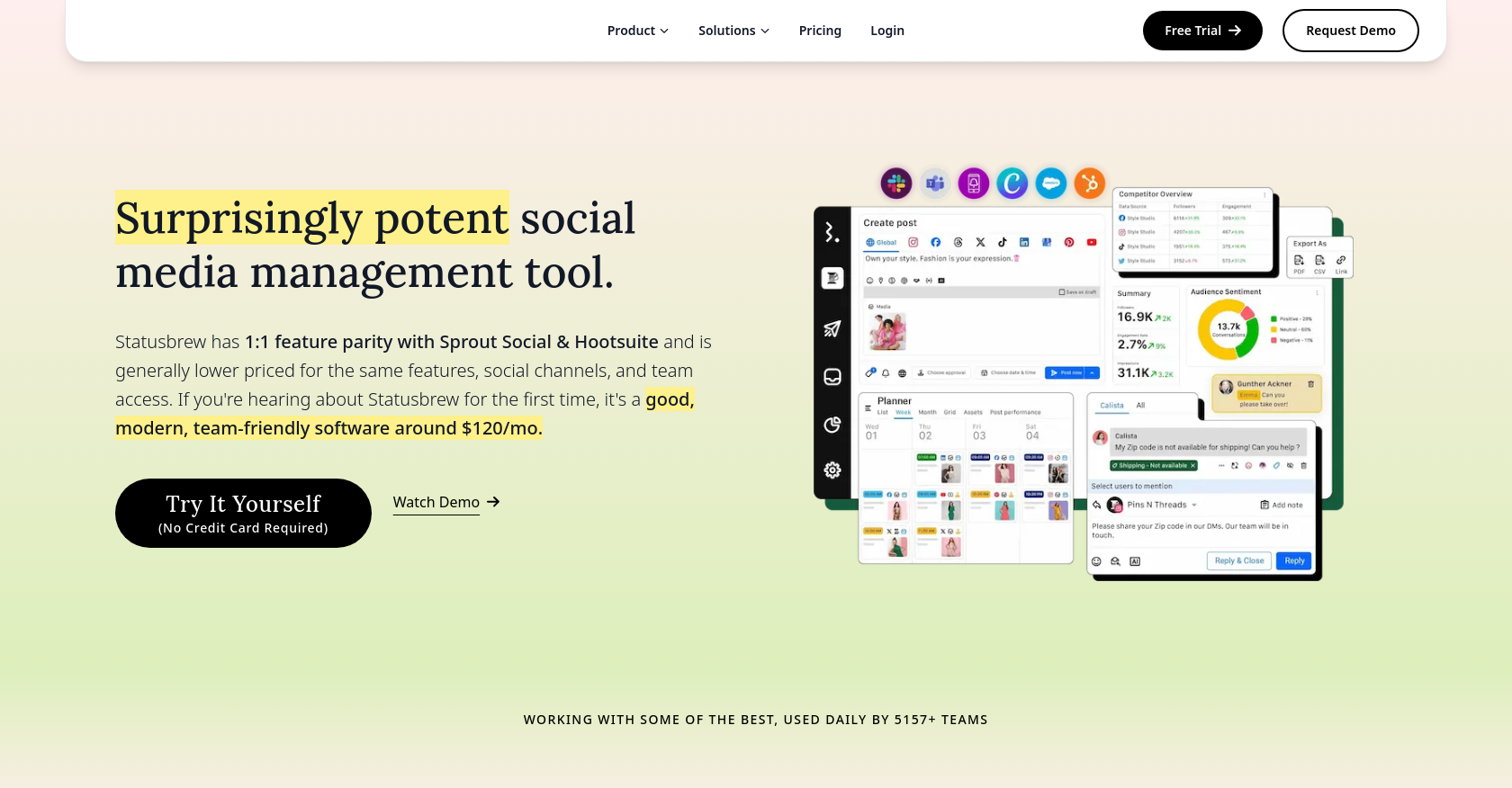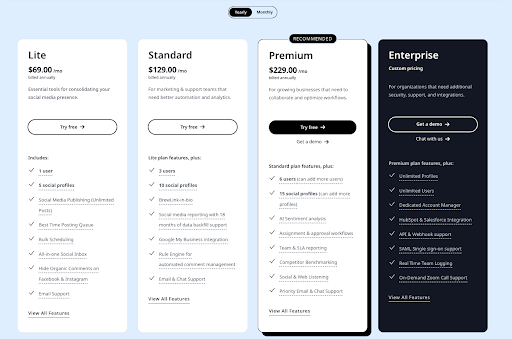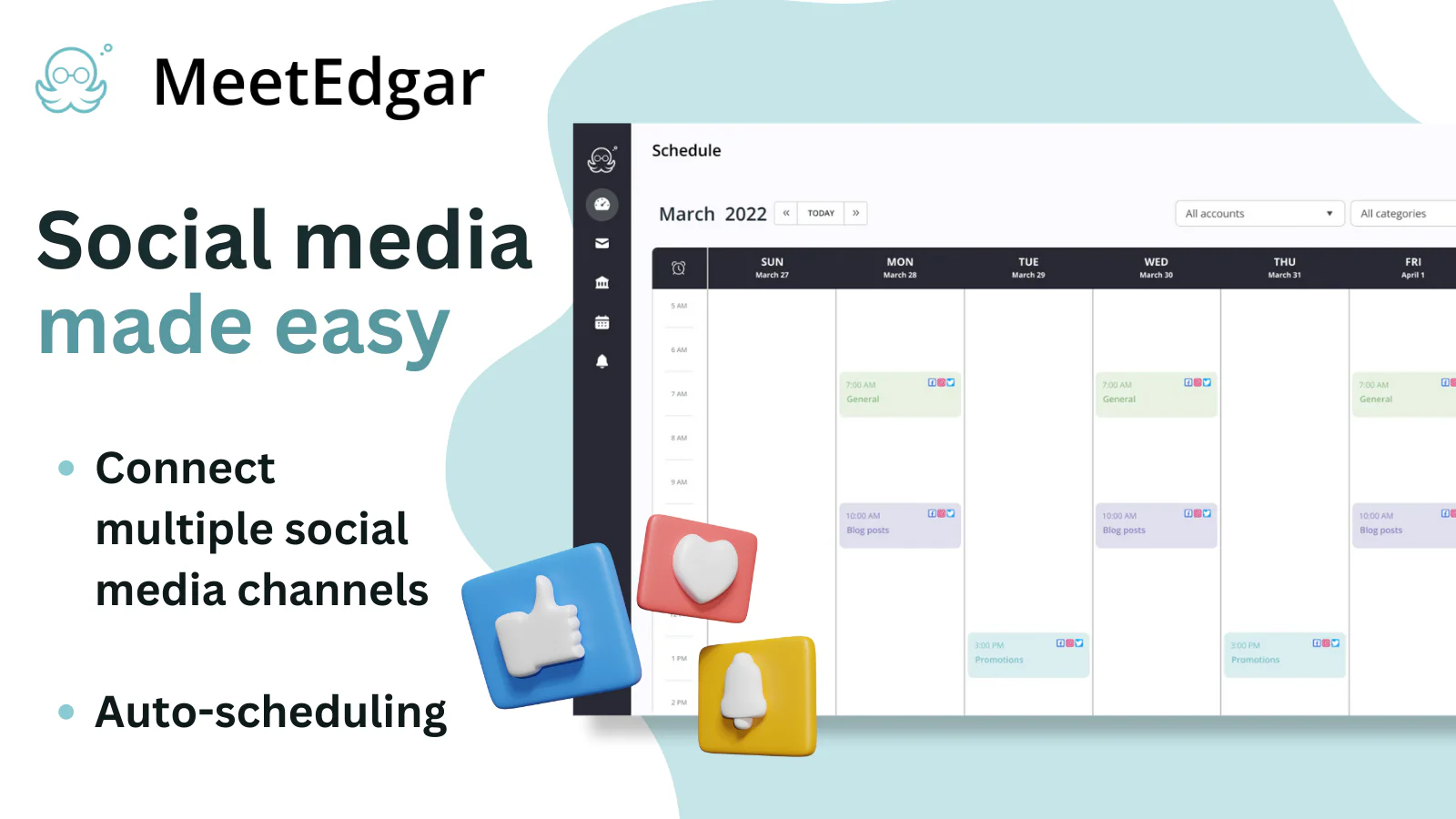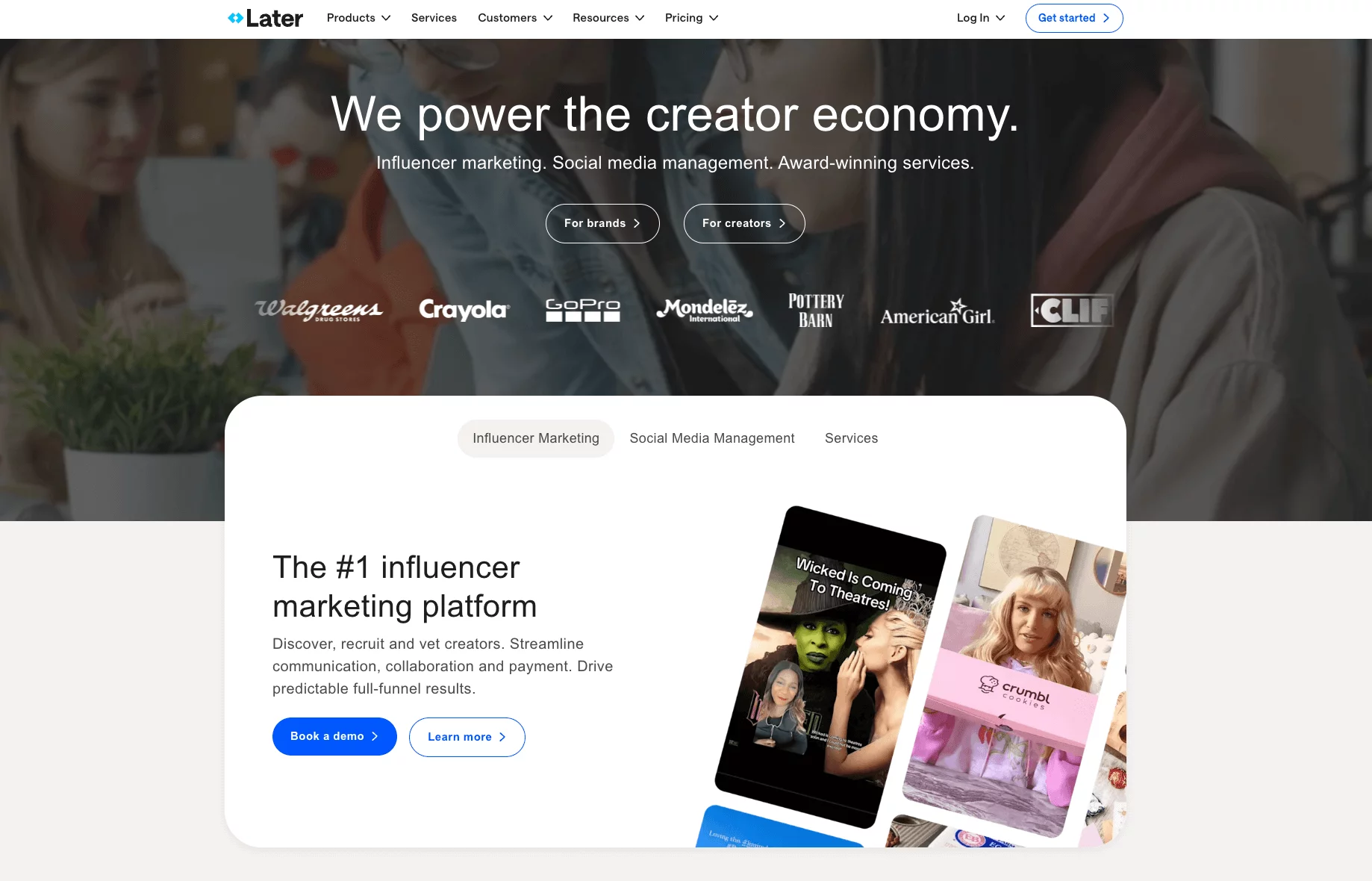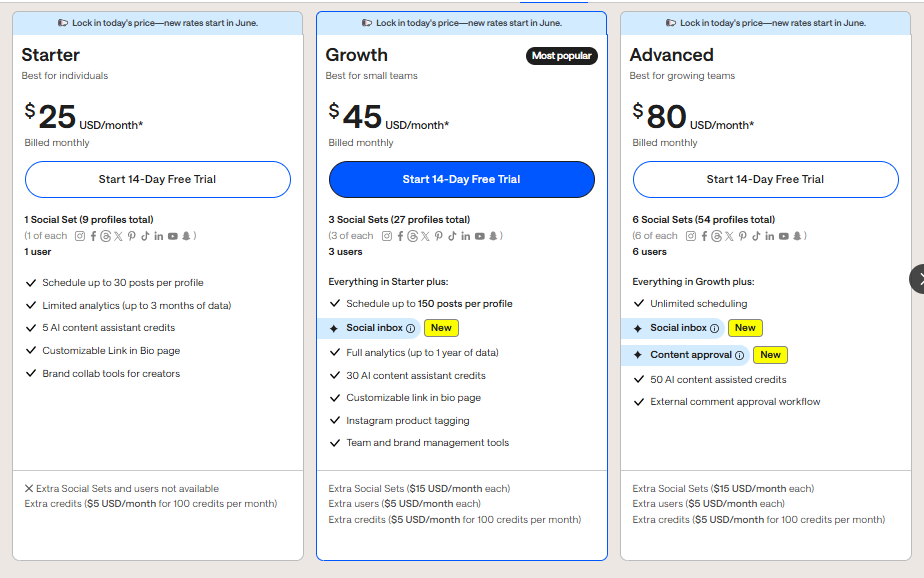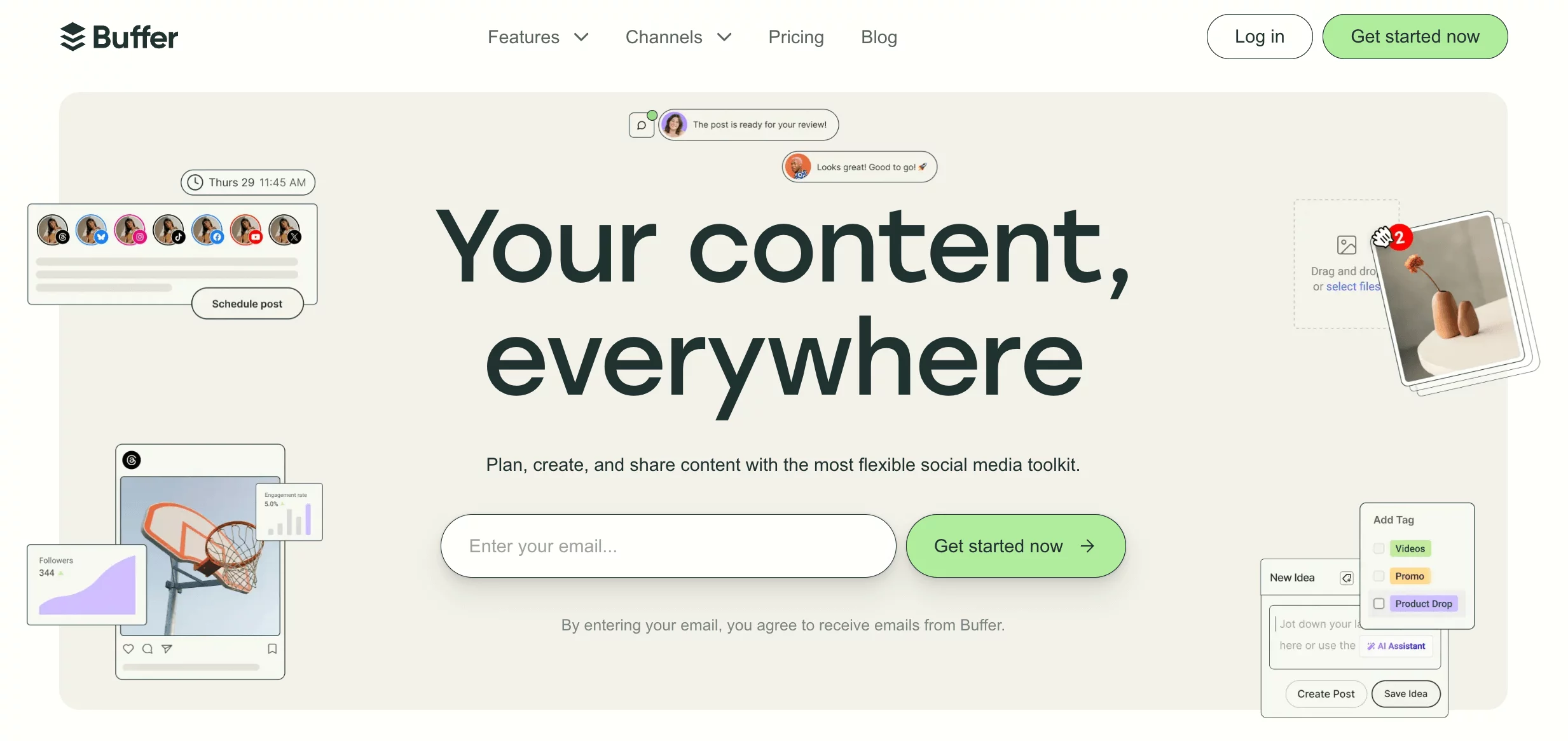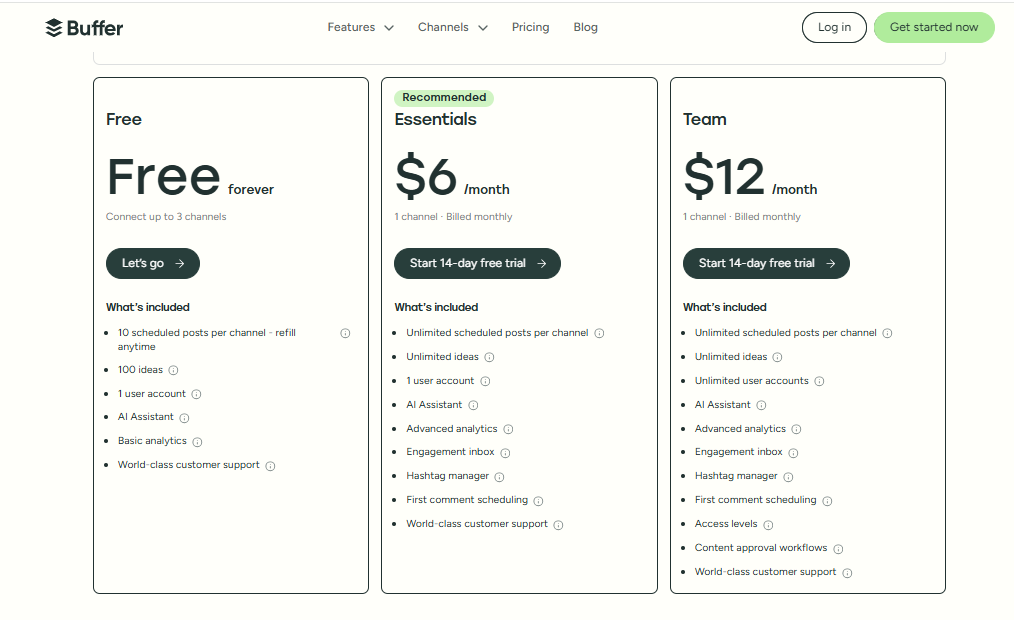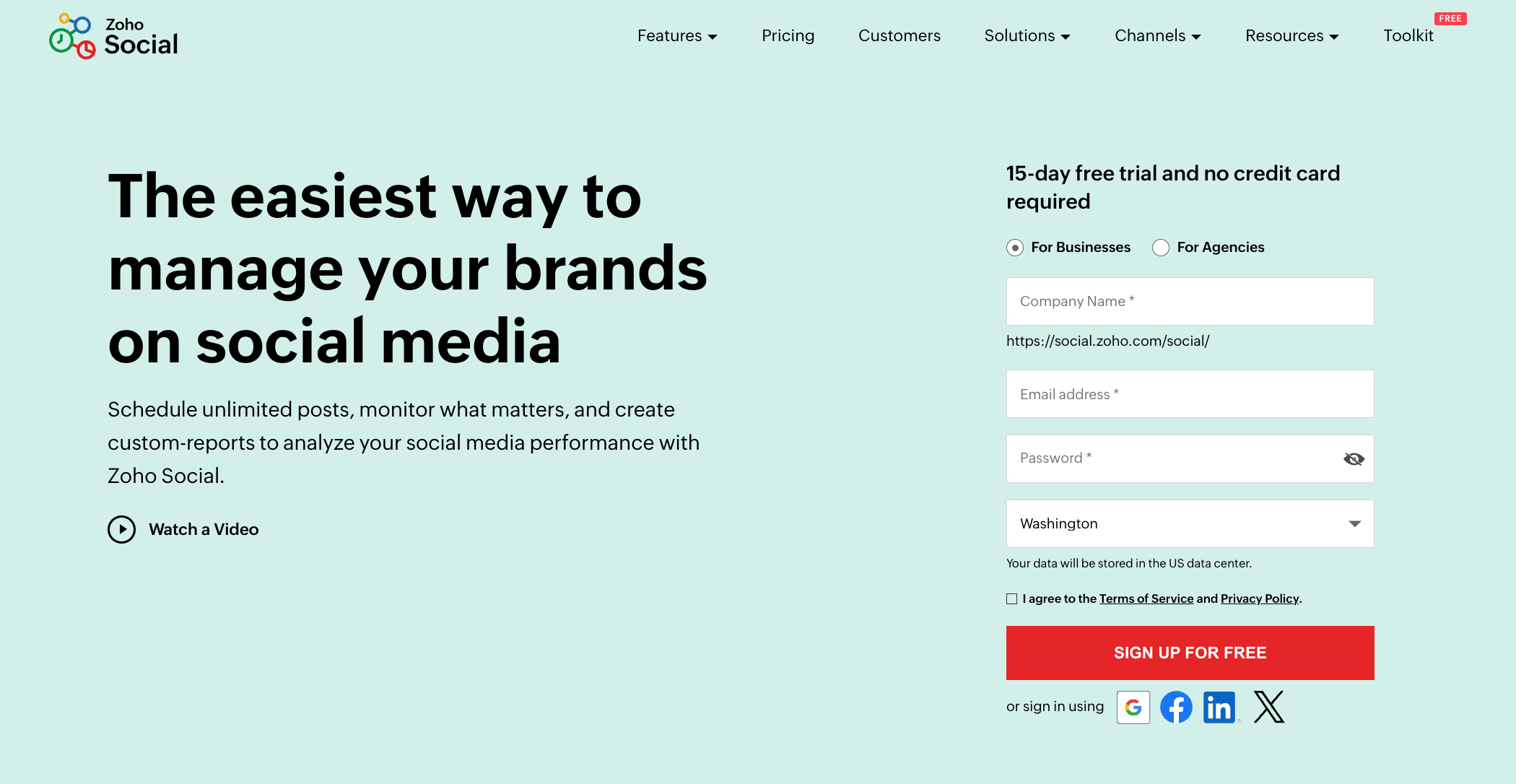8 Agorapulse Alternatives Worth Switching to in 2025 [First-Hand Review]

Agorapulse not cutting it anymore? You’re not alone.
Maybe it started with a missed report. Or a scheduling clash you couldn’t quite explain.
One minute, you’re praising Agorapulse for its tidy layout and handy features. The next, you’re knee-deep in workarounds, wishing things just worked better.
Truth is, a lot of marketers hit this wall.
As your social media demands grow, so does your need for flexibility, smarter insights, and tools that adapt, not limit.
Agorapulse gets a lot right, but it’s not perfect. Rigid pricing tiers, basic analytics, and limited collaboration features have left many users asking: Is there something better out there?
Yes. There is.
I’ve spent time exploring the top contenders, including one we’ve built ourselves, and I’m ready to walk you through 8 Agorapulse alternatives that are genuinely worth your attention in 2025.
Let’s dive in!
Table of Contents
- 1 Why Consider an Agorapulse Alternative?
- 2 Top 8 Agorapulse Alternatives to Consider for Your Brand in 2025
- 3 1. OnlySocial – A Smart, Scalable Alternative That Actually Makes Life Easier
- 4 2. Hootsuite – A Veteran in the Game with Enterprise Power
- 5 3. CoSchedule – A Calendar-First Tool for Content-Driven Teams
- 6 4. Statusbrew
- 7 5. MeetEdgar – Smart Automation for the Always-On Marketer
- 8 6. Sendible – Perfect Agorapulse Alternative for Agencies on the Move
- 9 7. Later – Built for the Visual Storyteller
- 10 8. Buffer – Affordable Agorapulse Alternative
- 11 9. Zoho Social – The Scalable Scheduler That Plays Well with CRM
- 12 How to Choose the Right Agorapulse Alternative for Your Brand
- 12.0.1 What’s your budget, and how fast are you growing?
- 12.0.2 Are you a visual brand or a data-driven one?
- 12.0.3 Do you need collaboration or are you flying solo?
- 12.0.4 Is engagement part of your strategy, or just scheduling?
- 12.0.5 How important are integrations?
- 12.0.6 What kind of reporting do you actually need?
- 13 Over to You
- 14 FAQs
Why Consider an Agorapulse Alternative?
Agorapulse has earned a solid reputation in the social media management space. It’s reliable, it’s professional, and it ticks a lot of boxes, especially for agencies and larger teams.
But that doesn’t mean it’s the right fit for everyone.
In fact, more and more users are starting to question whether Agorapulse still delivers the value it promises, especially when compared to newer, more flexible platforms on the market.
From pricing concerns to missing features, several pain points keep showing up in user reviews.
Let’s break them down.
Lacks Basic Functions in Starter Plan
One of the most common complaints? The Starter plan is too limited for the price. Basic functions like tagging users you’re engaging with are either restricted or completely absent, which forces small teams to upgrade earlier than expected.
For solo marketers and small businesses, that’s a roadblock right out of the gate.
Missing Key Features at Lower Tiers
Agorapulse covers the basics well, but when it comes to advanced content curation, detailed social listening, or flexible reporting, users often find themselves coming up short, unless they upgrade to a premium plan.
Other tools offer similar (or better) features at a lower cost, which makes it hard to justify staying.
Too Expensive for Smaller Teams
Agorapulse starts at $79/month, and that’s before you add extra users or features. For growing teams or solo creators on a budget, it’s a tough pill to swallow, especially when other platforms offer comparable (or better) functionality for half the price.
Technical Bugs and Glitches
For a tool at this price point, users expect stability. But reviews on platforms like G2 and Trustpilot highlight recurring bugs, from scheduling hiccups to laggy load times and sync issues.
And when you’re managing multiple clients or accounts, even a small bug can disrupt a big part of your workflow.
So… Is It Still Worth It?
If you’re running a large team with complex approval processes and enterprise-level needs, Agorapulse might still be a good fit. But if you’re looking for something more affordable, more flexible, or just more intuitive to use, there are better options out there.
And that’s exactly what this guide is here to help you find.
Top 8 Agorapulse Alternatives to Consider for Your Brand in 2025
1. OnlySocial – A Smart, Scalable Alternative That Actually Makes Life Easier
No doubt, OnlySocial is one of the best social media management tools out there on several levels. And that makes it a worthy Agaropulse alternative to consider for your brand this year.
OnlySocial was born out of frustration with clunky platforms, rigid pricing, and features that looked good on paper but didn’t hold up in day-to-day use.
The tool feels smooth to use, works across all the major platforms, and doesn’t make you do mental gymnastics just to schedule a post or pull a report.
What’s interesting is how it’s grown – not just in features, but in the kind of users it attracts. Startups, agencies, and even larger brands swear by the efficiency of Onlyocial and how adaptable it is.
Let’s break down what it actually does well.
Key Features
Cross-platform scheduling
OnlySocial supports posting to over 15 platforms. Instagram, Facebook, LinkedIn, TikTok, Pinterest, Threads, Bluesky – you name it. The interface is refreshingly straightforward, even when you’re juggling multiple accounts. No flipping through tabs or clunky drop-downs.
Visual calendar with bulk upload
The calendar view is where I spend most of my time. It’s drag-and-drop, bulk-friendly, and color-coded for clarity. You can upload hundreds of posts via CSV, reshuffle campaigns with ease, and get a bird’s-eye view without the mental clutter.
Managing Instagram and Facebook messages in one place sounds small, but if you’re doing any kind of community management, it saves real hours. No more bouncing between apps or missing replies.
Built-in AI assistant
The AI assistant is surprisingly sharp. It helps brainstorm captions, recommends hashtags, and even helps generate quality visuals based on post context. After a while, it starts mimicking your brand tone, so you’re not starting from scratch each time.
Smart analytics dashboard
Here’s where OnlySocial nails it: the reporting is clear. You can see what’s working (and what’s not), broken down by platform, audience, post type, and engagement time. If you’re used to downloading a CSV and playing detective, this is a big upgrade.
Streamlined team collaboration
I’ve used this in team settings too, and the workflow is seamless. You can assign roles, leave internal notes, store brand assets in one shared library, and manage approvals without a single “where’s that file?” moment.
Seamless third-party integrations
OnlySocial plugs right into tools like Adobe Express, Bit.ly, and OpenAI. These seamless integrations help you work faster and smarter, all from within the same dashboard.
Pros
- Offers affordable plans. You get advanced features without committing to expensive monthly plans.
- Clean, intuitive interface that makes scheduling and managing posts feel effortless.
- Insightful analytics and smart hashtag suggestions
- Bulk upload up to 500 posts at once, perfect for busy teams who want to plan weeks of content in one sitting.
Cons
- No built-in competitor analytics yet
- No forever-free plan
Our Experience with OnlySocial:
After spending real time inside OnlySocial, testing it across multiple client projects and team setups, here’s what we found.
OnlySocial seems to outperform Agorapulse in many ways, especially when it comes to flexibility, pricing, and everyday usability.
Publishing & Scheduling
This was one of the first areas where OnlySocial really impressed us.
We were able to bulk schedule up to 500 posts at once using a simple CSV upload. That’s more than double what Agorapulse allows. And when you’re managing content across several platforms, that difference matters.
Another standout? The First Comment tool.
Being able to schedule the first comment (with hashtags, CTAs, or extra context) made our Instagram posts perform better. It’s one of those small things that helps boost engagement without needing a separate workflow.
Content Planning & Creation
We weren’t just posting – we were planning.
OnlySocial’s collaborative Instagram posts were a hit with our team. Co-authoring content directly from the platform allowed us to tag in collaborators easily and publish posts across multiple accounts at once.
That kind of coordination isn’t possible in Agorapulse.
Also, being able to tag collaborators before the post goes live (and have it show on their feed once accepted) meant better reach with far less manual follow-up.
Team Collaboration & Analytics
This is where we started to notice the real difference.
With Agorapulse, collaboration feels a bit… segmented. You can assign roles, sure, but the workflow starts to feel rigid fast.
In contrast, OnlySocial’s collaborative calendar and shared content library gave us breathing room.
Everyone on the team could jump in, leave internal notes, assign posts, and manage approvals – all without overlapping or causing confusion.
As for the analytics, this was one of the biggest wins. The dashboard goes beyond basic metrics. We could clearly see which posts were driving clicks, what times were working best, and how different platforms were performing. It turned guesswork into decisions.
Pricing & Value
Let’s talk numbers.
Agorapulse charges $79/month for 10 social accounts. With OnlySocial, we paid just $29/month and managed 15 accounts. That’s not a small difference – it’s a budget decision that makes sense, especially for small agencies or solo marketers managing multiple brands.
Here’s how the plans break down:
- Freelancer Plan – $29/month for 15 social media accounts
- Entrepreneur Plan – $49/month for 45 accounts and 3 users
- Professional Plan – $99/month for 150 accounts and 10 users
Overall Verdict
After using both tools side by side, OnlySocial came out ahead for us, not just in pricing, but in the areas that matter most: scheduling, collaboration, and insights.
If you’re feeling boxed in by Agorapulse’s limitations, OnlySocial offers a real, well-rounded alternative. It’s flexible, efficient, and feels like it was designed by people who actually manage social media every day.
And for us, that made all the difference.
2. Hootsuite – A Veteran in the Game with Enterprise Power
Hootsuite has been around long enough to become a household name in the social media world, and that legacy shows. It’s a robust, all-in-one platform built with power users in mind.
From scheduling and analytics to social listening and even paid ads, Hootsuite has nearly every feature you can think of. And if you’re managing a large, fast-moving team or an enterprise-level social presence, it can absolutely get the job done.
That said, the platform can feel a bit heavy for smaller teams, both in terms of pricing and ease of use. It’s a solid tool, but not always the most accessible one.
Key Features:
- Scheduling and publishing
- Real-time team collaboration
- AI content creation
- Social media calendar
- Advanced social listening
- UCG and influencer management
- In-depth analytics capabilities
- Paid social media ads management
Pros
- Let’s you design, schedule, and publish content for multiple platforms from a central dashboard with minimal friction.
- Includes basic AI-powered social listening to help track trends and sentiment around your brand.
- Offers a unified inbox with smart team tools like saved replies and agent collision prevention.
- Customizable analytics and benchmarking make it easy to track performance at scale.
Cons
- The pricing plans are on the higher end, which can quickly become unmanageable for small teams and solo users.
- Its wide range of features comes with a steep learning curve
- Support response times aren’t always consistent when help is needed.
Our Experience:
We’ve used Hootsuite on and off over the years – mainly for larger campaigns where we needed deeper monitoring and analytics.
It’s one of those tools that does a lot, but also demands a bit from you in return. If you’re stepping into it for the first time, expect a learning curve.
Publishing & Dashboard Experience
Hootsuite’s publishing tools are reliable, no doubt. We were able to schedule and post across multiple channels without hiccups.
That said, the dashboard can feel a little crowded. With so many features competing for attention, it took our team some time to get comfortable navigating the interface.
One thing worth mentioning is Streams – Hootsuite’s real-time monitoring hub.
At first, it felt like information overload. But once we customized the feed, it became a powerful way to keep track of brand mentions, comments, and industry trends all in one place.
Some of us found it a bit overwhelming; others loved the control it gave us.
Adoption & Workflow Challenges
As Hootsuite keeps adding new features to stay competitive, we noticed a lag in adoption. It’s not that the features aren’t useful – they are. It’s just that getting everyone up to speed takes time.
If your team isn’t already familiar with Hootsuite, be prepared to invest in onboarding or risk underusing what you’re paying for.
This isn’t ideal for lean teams who need to hit the ground running.
Pricing & Value
Here’s where Hootsuite started to lose us a bit.
The Professional plan costs $99/month for just one user and 10 accounts. And if you need to add team members or expand your profile list, the Team plan jumps to $249/month.
Compare that with other tools on this list, and it starts to feel pricey, especially for agencies managing multiple brands or small businesses trying to stay nimble.
Overall Verdict
Hootsuite still brings serious firepower to the table, especially if you’re a larger organisation needing features like sentiment analysis or in-depth reporting.
But for smaller teams or anyone coming from Agorapulse hoping to save time and money, it might feel like more than you need, and more than you want to spend.
It’s a solid platform, no doubt. But only if you’ve got the resources and patience to unlock its full potential.
3. CoSchedule – A Calendar-First Tool for Content-Driven Teams
CoSchedule isn’t just a social media tool; it’s more like a digital command center for your entire content operation.
At its core, it’s a marketing calendar built to help teams plan, post, and manage everything from blogs to campaigns to social posts – all in one place. If your content and social workflows are closely tied together, CoSchedule makes a lot of sense.
Key Features:
- Centralized content scheduling
- Social media automation
- Bulk scheduling
- Conversation tracking
- Automates rescheduling
- Hire Mia AI assistant
- Team collaboration
- Analytics and reporting
Pros
- The unified content calendar makes it easy to plan and manage social posts across multiple platforms in one view.
- Great for content marketing teams who need shared visibility and tighter coordination across projects.
- Combines social scheduling with blog publishing and task assignments, cutting down tool-switching.
- Colour-coded task planning makes campaign organisation and progress tracking incredibly visual and clear.
- ReQueue feature saves time by automatically recycling evergreen content across your channels.
Cons
- It’s more expensive than other simple calendar tools and may feel heavy for basic social scheduling.
- Might be overkill if you’re only looking to schedule posts without needing blog or project management.
- Reporting and analytics feel limited, especially if you’re used to the depth of platforms like Agorapulse.
- There’s a noticeable learning curve, especially for teams trying to adopt it quickly without structured onboarding.
Our Experience with CoSchedule
We tried CoSchedule with a focus on how well it could streamline both content and social workflows – and for the most part, it did exactly that.
The social media organizer was easy enough to get into and allowed us to bulk upload posts, assign campaigns, and monitor our publishing queues without needing to leave the dashboard.
One thing we found especially useful was the read-only calendar view, which made it easy to share plans with clients without worrying they’d accidentally move something around.
Where it really stood out was the ReQueue feature. It automatically recycled our evergreen content, saving us from the usual “what should we repost this week?” scramble.
That said, we had to spend a bit of time configuring what should and shouldn’t be repeated.
Team collaboration was smooth thanks to task assignments and project tracking. We could set deadlines, add internal comments, and see who was working on what in real time.
If your team juggles content across blogs, social media, and email, this level of visibility is a win.
The catch? Analytics felt a bit underwhelming. You get top-level numbers, but nothing too deep. We still needed external tools to really dig into what was working.
Pricing and Value
CoSchedule’s pricing is more flexible than Agorapulse’s, and its entry-level plans are decent for small teams.
- Free Calendar – 1 user, 2 social profiles: $0/month
- Social Calendar – 3 users, 5 social profiles: $19/month
- Agency Calendar – 3 users, 5 profiles + extra features: $49/month
- Marketing Suite – Custom plans based on team size and needs
If you’re an agency managing multiple clients, the Agency Calendar plan offers a lot of bang for the buck, but make sure you’re going to use the extra features, or it may not be worth the upgrade.
Final Verdict
CoSchedule is a smart option for content-heavy teams that need more than just a scheduler. It’s best for marketers who want their blog, campaign, and social tools all working from the same calendar.
For agencies and consultants managing a mix of deliverables, the collaborative workflows and repeat-post automation make life easier.
But if you’re after deep analytics or a lightweight scheduling tool, this one might feel like too much for too little.
4. Statusbrew
Statusbrew is a modern alternative to Agorapulse, balancing powerful features and day-to-day usability. It’s built for agencies, growing teams, and businesses that need more than just scheduling without the complexity or per-user price tag of platforms like Agorapulse.
From advanced publishing and multi-level approvals to a unified inbox that handles organic comments, ad replies, and reviews, Statusbrew simplifies social workflows while giving you precise control over every touchpoint. It’s 60+ automation rules help route conversations, hide spam, and label content instantly, making your team more efficient.
The reporting engine is another strong point. Using 250+ metrics, you can build client-ready dashboards, filter data by labels or campaign goals, and export visuals that make sense in presentations.
Key Features:
- Unified inbox for all engagement types (organic, ads, reviews)
- Custom reports with 250+ KPIs
- Smart content labels for reporting and organization
- Rule-based automation for moderation and workflows
- Multi-step content approvals (internal + client-facing)
- Canva integration and media library
Pros
- Intuitive UI with fast adoption, even for larger teams
- Powerful automation engine to reduce manual tasks
- Clean, shareable reports tailored for clients and stakeholders
- More affordable than Hootsuite or Sprout or Agorapulse, with flexible user plans
Cons
- Fewer deep listening features compared to Hootsuite or Sprout Social
- Not built for influencer campaigns or UGC workflows
- Some advanced features require initial setup and onboarding
Our Experience:
What stood out was how quickly we were able to get started. Statusbrew’s interface is focused, and we didn’t feel buried under features. Publishing, comment moderation, and reporting were all smooth from day one.
The inbox felt like a major upgrade – comments from dark posts, ad replies, and Google reviews were all in one place and auto-assigned to the right team member.
Reporting was also easy to customize. We created labeled dashboards per client without needing help from support or wasting hours exporting CSVs.
Adoption & Workflow Fit
Statusbrew’s learner approach, compared to Agorapulse, helped us onboard new users faster. The approval flows were beneficial when working with external clients or internal brand teams. Everything felt collaborative but in control.
It may not be for teams heavily reliant on social listening or influencer marketing, but it ticks all the boxes for publishing, engagement, and reporting.
Pricing & Value
Statusbrew offers excellent value, especially for teams managing multiple brands. Plans start at $69/month (1 user, 5 profiles), and go up to $229/month (6 users, 15 profiles), with enterprise plans available.
The pricing structure is clear and doesn’t scale aggressively like Agorapulse’s per-seat model, making it easier to plan around your team’s actual needs.
Overall Verdict
If you’re looking for a social media management tool that offers control, clarity, and cost efficiency, Statusbrew is one of the strongest Agorapulse alternatives.
It’s especially well-suited for agencies and growing teams that need clean workflows, meaningful automation, and powerful and easy-to-share reporting.
5. MeetEdgar – Smart Automation for the Always-On Marketer
MeetEdgar takes a simple, focused approach to social media management. And for the right users, it works beautifully.
If you’re a freelancer, blogger, or a small team juggling lots of content with limited time, this tool was clearly made with you in mind.
Instead of just helping you schedule content, MeetEdgar is built around automating your social posting. It keeps your feeds active by pulling from a library of evergreen content, shuffling the order, and reposting regularly, so you’re not always stuck thinking, “What do I post today?”
Key Features:
- Category-based Custom Scheduling
- Automated writing assistance
- Auto-refill queue
- RSS Feed
- URL Shortener
Pros
- The reposting feature helps maximize the shelf-life of your best content without manual re-scheduling.
- You can create multiple variations of a post and let the system smartly tailor and queue them for each platform.
- Content categories let you automate an entire week of posting while keeping a solid mix of topics.
- There are no surprise fees – everything is included, which makes budgeting refreshingly straightforward.
Cons
- Lacks features like social listening, inbox management, and deep analytics that growing teams often rely on.
- Feels a little pricey considering it doesn’t offer team collaboration or engagement tools like other platforms in this list.
- Best suited for freelancers or small teams; larger businesses may outgrow it quickly.
Our Experience with MeetEdgar:
If you are a freelancer, blogger, or run a small agency, MeetEdgar is a great Agorapulse alternative you might want to consider. We put it to the test, and it delivered exactly what we needed.
Setting up content categories was a breeze. The tool allowed us to split posts into buckets like “Tips,” “Throwbacks,” and “Testimonials,” and Edgar rotated through them with zero fuss.
The ability to create post variations for different platforms saved us time and made the content feel more native across channels.
The scramble feature was one of our unexpected favorites. It helped mix things up so the feed didn’t feel robotic, even though everything was automated behind the scenes.
We also liked that we could build an unlimited content library and run A/B tests to see which headlines or post types were getting the most traction. While the analytics are simple, the insights were enough for lightweight performance checks.
That said, we definitely noticed the absence of a centralized inbox and deeper analytics. If you’re looking to engage with comments or measure your campaign impact across multiple platforms in detail, you’ll hit limitations fast.
Pricing and Value
MeetEdgar keeps things simple with two plans:
- Eddie Plan – $29.99/month for 5 social media accounts
- Edgar Plan – $49.99/month for 25 accounts
You get full access to automation tools, unlimited content storage, and no extra add-ons to worry about. And with their 30-day money-back guarantee, there’s very little risk in trying it out.
The pricing is reasonable for solopreneurs and small teams, but again, if you’re managing multiple brands or need more advanced tools, the value starts to taper off.
Final Verdict
MeetEdgar is built for consistency. It’s not trying to be an all-in-one social media suite, but that’s exactly why it works so well for content marketers, bloggers, and solo creators who want to stay visible without burning out.
If you’re after simple automation and evergreen scheduling, it’s a solid alternative to Agorapulse. But if you need collaborative workflows, deep insights, or direct audience engagement, this one might leave you wanting more.
6. Sendible – Perfect Agorapulse Alternative for Agencies on the Move
Sendible isn’t your average social media tool; it’s clearly built with agencies, freelancers, and multi-brand managers in mind.
Right out of the box, it feels like the platform wants to help you succeed. The onboarding is thoughtful, the UI is tidy, and everything from scheduling to reporting happens in a centralized hub that’s easy to follow.
If you manage content for several clients at once, Sendible feels like a project manager and a scheduler rolled into one.
Key Features:
- Simplified content scheduling
- Smooth workflows and approval process
- Priority inbox
- Ad performance insights
- White label dashboard
- Analytics and reporting
- Smart compose box
- Team and client collaboration
- Shareable social media Calendar
Pros of Sendible
- Onboarding is smooth and helpful
- The content calendar is well-designed, giving you a clear, drag-and-drop overview of scheduled posts and campaigns.
- Customer service stands out with quick-response and helpful best practices and guides.
- The Smart Compose Box makes it easy to draft, review, and approve content collaboratively across teams and clients.
Cons
- Still doesn’t support direct publishing to Instagram
- Occasional bugs and minor glitches have been reported, which can cause friction during peak campaign times.
- Support is available only in English, which may be a challenge for international teams or clients.
Our Experience:
Sendible is the real deal when it comes to workflow management. The Smart Compose Box helped streamline communication between our internal team and clients, cutting down on endless email threads and unnecessary revisions.
Being able to tag posts, assign locations, and bulk schedule everything in one go was a time-saver, especially during busy campaign launches.
The centralized content calendar gave us full visibility across all accounts, and it was easy to reschedule or tweak campaigns on the fly.
That said, the lack of direct Instagram publishing was a real sticking point. Having to rely on push notifications or reminders to publish manually isn’t ideal, especially when your Instagram content is a core part of the strategy.
Also, while the shared inbox helped us stay on top of comments and messages, some team members ran into minor bugs, nothing deal-breaking, but enough to notice.
Pricing & Value
Sendible’s pricing is structured to scale with your team size and client load:
- Creator Plan – $25/month for 1 user and 6 social profiles
- Traction Plan – $76/month for 4 users and 24 profiles
- Scale Plan – $170/month for 7 users and 49 profiles
- Expansion Plan – $204/month (annual billing) for 10 users and 60 profiles
- White Label Plans – Custom pricing for agencies with up to 50 users and 300 profiles
While it’s not the cheapest option out there, the platform’s agency-focused tools and white-label capabilities can justify the price – if you’re using those advanced features regularly.
Final Verdict
Sendible is a strong alternative to Agorapulse, especially for agencies, consultants, and content teams managing multiple clients.
It offers streamlined workflows, excellent onboarding, and a professional feel that scales with your needs.
However, it’s not without its trade-offs. Direct Instagram publishing is still missing, and deeper analytics features are locked behind higher-tier plans.
If you’re willing to work around those gaps, or don’t need those features to begin with, Sendible could be exactly what your team needs.
It’s organized, customizable, and collaborative. And for many teams, that’s a winning combo.
7. Later – Built for the Visual Storyteller
If your social strategy is rooted in aesthetics and focuses on platforms like Instagram, Pinterest, or TikTok, Later was designed with you in mind.
It’s not trying to be an all-in-one command center like Agorapulse. Instead, Later focuses on making visual content planning easier, smoother, and actually fun.
From its drag-and-drop calendar to its media library and grid preview, Later feels more like a creative studio than a traditional scheduler.
And for brands that live and breathe visuals, that’s a huge plus.
Key Features:
- Intuitive content calendar
- Link in bio integration
- AI-powered captions
- Centralized dashboard
- Team and client collaboration
- Content management hub
- Unified social inbox
- Comprehensive analytics
Pros
- A perfect fit for visual-first brands
- The Link in Bio tool is free and flexible
- The drag-and-drop scheduler, clean interface, and media tagging features keep things intuitive.
- The mobile app is solid
Cons
- No engagement inbox – you won’t be able to reply to comments or messages directly from Later.
- Advanced features locked behind higher-tier plans
- Not ideal for text-heavy platforms LinkedIn and Twitter/X.
Our Experience:
If you’re used to Agorapulse’s functional, all-in-one vibe, Later might feel like a shift – but not a bad one.
This is a tool that thrives in the hands of creators, visual marketers, and ecommerce teams who care about how things look, not just what they say.
The Instagram Visual Planner is a standout. It lets you build your grid in advance and move things around until your feed looks just right. You don’t just post content; you shape your brand story.
You’ll also appreciate the media library, especially if you’ve got a lot of photo and video assets to manage. Organizing content with tags, labels, and folders helps speed things up.
And if you’re big on community engagement, the UGC discovery tool makes it easy to source content from fans and customers, all without leaving the platform.
That said, if engagement, reporting, or deep performance insights are key parts of your workflow, you’ll start to see Later’s limits.
There’s no unified inbox, and the analytics are more helpful than deep. While this could be great for creators, it may not be enough for agencies tracking ROI.
Pricing & Value
Later offers competitive pricing, especially if you’re a creator or a small team just getting started.
- Starter Plan – $25/month for 1 user and 9 social profiles
- Growth Plan – $45/month for 3 users and 15 profiles
- Advanced Plan – $80/month for 6 users and 30 profiles
- Agency Plan – Custom pricing for larger teams with higher volume needs
There’s also a 14-day free trial to test the waters before you commit. Compared to Agorapulse’s entry point of $79/month, Later offers better upfront value, especially for visual brands that don’t need heavy-duty analytics or engagement tools.
Overall Verdict
Later isn’t trying to be everything, and that’s part of its charm. If your brand identity lives in visuals, and your priority is how your feed looks rather than how it converts, this tool will feel like home.
It’s an excellent Agorapulse alternative for creators, ecommerce businesses, and visual-first brands who want clarity and control over their content calendar.
Just know that you may need to pair it with other tools if engagement and performance tracking are core to your workflow.
8. Buffer – Affordable Agorapulse Alternative
Buffer was built for solo creators, small business owners, and lean teams who want the essentials without the overwhelm.
It won’t try to wow you with a hundred features you’ll never use. Instead, it focuses on scheduling, engagement, analytics, and ease of use – and it does all four really well.
It’s the tool you open on a Monday morning and just get things done with.
Key Features:
- Queue and schedule posts
- Multi-platform publishing
- In-depth analytics
- Unified engagement tool
- AI content generator
- Visual social media calendar
Pros
- Buffer is beginner-friendly and beautifully simple
- A generous free plan to get you started
- Solid reporting for small teams
- AI assistant for caption writing
- Start Page tool adds extra value
Cons
- While it’s budget-friendly at first, the cost adds up if you’re managing several profiles across multiple platforms.
- Limited listening and monitoring tools
- Customer support can be a bit slow
Our Experience with Buffer
Buffer is about doing more with less fuss. The scheduling process is intuitive. The layout is easy on the eyes. And the tool genuinely feels like it was designed with creators and time-strapped teams in mind.
The content publishing tools are flexible. You can queue posts across platforms, customize messages for each channel, and even get help from its built-in AI assistant when the ideas just aren’t flowing.
It supports all the core platforms, including Facebook, Instagram, X (Twitter), LinkedIn, Pinterest, etc., and integrates smoothly with tools like OpenAI, Adobe Express, and Bitly, which is a bonus.
Analytics is another strong area for Buffer. While it doesn’t go as deep as Agorapulse, it gives you exactly what most people need – engagement rates, top-performing content, audience growth, and best posting times.
It tells you what’s working, what’s not, and where to go next.
You also get access to a unified inbox for managing comments and DMs, and Buffer’s Start Page lets you build a mini link hub, which is perfect for Instagram bios or short-term campaigns.
Pricing & Value
Buffer is one of the most affordable tools on this list. Its pricing is designed to be flexible, especially for smaller teams.
- Free Plan – Includes 3 social channels and 10 scheduled posts per channel
- Essentials – Starts at $6/month per channel (great for solo users)
- Team Plan – $12/month per channel (adds user collaboration and permissions)
- Agency Plan – $120/month for 10 channels and multiple users
Compared to Agorapulse’s $79/month starting price, Buffer clearly offers more flexibility at the entry level. If you’re scaling slowly or running a lean team, it gives you the essentials without locking you into a big contract.
Final Verdict
Buffer is a great Agorapulse alternative if your focus is on ease, clarity, and value for money.
It’s especially appealing to creators, small businesses, and marketers who want just the right tools, without all the extra noise.
It won’t give you every advanced feature under the sun, but if you want a tool that helps you stay consistent, post with confidence, and track performance without stress, Buffer is an excellent fit.
9. Zoho Social – The Scalable Scheduler That Plays Well with CRM
If you’re already using Zoho tools like Zoho CRM or Zoho Desk, adding Zoho Social to your stack feels like a natural next step.
It’s designed to work in harmony with the rest of the ecosystem, offering a tight integration that helps teams manage everything from lead generation to customer support – all from a centralized dashboard.
Even if you’re not fully plugged into Zoho’s universe, the tool still holds its own. It offers all the core scheduling and monitoring features you’d expect, and it wraps them in a user-friendly interface that’s ideal for small to mid-sized businesses.
Key Features:
- Bulk scheduling and publishing calendar
- Listening dashboard and live streaming
- Statistics and analytics
- Customized reports
- Ads and CRM integration
- Browser extension
- Real-time response via desk integration
Pros
- Generous free plan for lean budgets
- Smooth integration with other Zoho apps
- Multiple team members can manage posts, share reports, and track activity without stepping on each other’s toes.
- You can turn social media messages into support tickets or leads, closing the gap between engagement and action.
Cons
- Advanced analytics are limited
- Users who must monitor their social media accounts while on the fly may find mobile app functionality challenging.
Our Experience with Zoho Social
Zoho Social offers a centralized, no-fuss dashboard where you can plan, schedule, and monitor posts across all your connected platforms.
The calendar view is simple but effective, helping you juggle multiple content pipelines without confusion.
If your business runs on collaboration, Zoho makes it easy to bring your team in. You can share reports, assign responsibilities, and review post approvals – all without switching tabs or tools. There’s even a client portal feature (for those on higher plans) that makes it easier to manage feedback externally.
Where Zoho Social stands out most is lead tracking. If you’re running Facebook Lead Ads, you can connect them directly to your Zoho CRM and track them in real time.
It’s a neat trick that saves you from the usual back-and-forth between platforms. You can also convert social media messages into tickets or tasks, which adds a layer of support and structure many other tools don’t offer at this price point.
That said, if you’re after deep-dive insights into sentiment, industry benchmarks, or competitor activity, Zoho might feel a little too surface-level.
Pricing & Value
Zoho Social offers flexible plans that scale with your team’s needs:
- Standard Plan – $15/month for 1 user and 10 social channels
- Professional Plan – $40/month for 1 user and 10 channels (adds monitoring and collaboration tools)
- Premium Plan – $65/month for 3 users and 11 channels
Zoho Social is priced lower than Agorapulse, and its value grows significantly if you’re already invested in the Zoho suite. Integration with CRM and helpdesk tools alone gives it an edge for businesses focused on lead generation and customer engagement.
Final Verdict
Zoho Social is one of the best Agorapulse alternatives for businesses that want solid scheduling tools, light automation, and deep CRM integration, without paying a premium.
It may not have the flashiest analytics or the deepest listening tools, but if you’re a small business or agency already using Zoho products (or planning to), this is a practical, budget-conscious solution that ties your workflows together.
How to Choose the Right Agorapulse Alternative for Your Brand
Not all social media tools are created equal, and that’s actually a good thing.
The key is choosing one that fits your workflow, not one that forces you to change how you work. While Agorapulse is a solid platform, the best alternative for your brand depends on what matters most to you.
Here are a few things to keep in mind before making your switch:
What’s your budget, and how fast are you growing?
Some tools (like Buffer and Zoho Social) offer generous free or entry-level plans. Others (like Sprout Social or Hootsuite) are built for big teams with deeper pockets. If you’re scaling fast or need more seats and profiles, consider how pricing will stack up in the long run.
Are you a visual brand or a data-driven one?
Later shines for content creators and ecommerce brands that care about how their feed looks. On the flip side, platforms like Sendible and CoSchedule lean more into analytics, workflows, and cross-team coordination. Pick one that supports your creative or analytical workflow.
Do you need collaboration or are you flying solo?
If you’re working alone, tools like Buffer or MeetEdgar keep things simple and manageable. But if you’ve got clients or a content team to coordinate with, go for platforms like OnlySocial, Sendible, or CoSchedule – they’re built for multi-user setups.
Is engagement part of your strategy, or just scheduling?
Some tools focus purely on publishing, while others (like Zoho Social or Hootsuite) offer inboxes, comment management, and even support ticket integration. If interacting with your audience is part of the plan, make sure your tool includes those features.
How important are integrations?
Already using tools like Canva, Google Analytics, or Zoho CRM? Choose a platform that integrates smoothly. OnlySocial and Zoho Social both do this well, saving you time and headaches in the long run.
What kind of reporting do you actually need?
You don’t always need deep-dive reports. But if you do, avoid tools that only give surface-level stats. Sendible, OnlySocial, and Hootsuite offer solid reporting options while MeetEdgar and Later keep it light and simple.
Over to You
Agorapulse has earned its place in the social media toolbox, but if it’s starting to feel like you’re paying premium for features you barely touch, it might be time for a smarter switch.
The truth is, your workflow shouldn’t have to bend around your platform. Whatever it is you’re doing, the right tool should fit both your needs and your budget.
From visual-first planners like Later to automation-savvy tools like MeetEdgar, and all-in-one workhorses like OnlySocial or Zoho Social, there’s no shortage of capable, affordable Agorapulse alternatives out there.
And many of them are doing things more efficiently, more intuitively, and without the high price tag.
So, take your pick. Test a few. Choose the one that makes managing your content feel less like a chore and more like a creative rhythm.
Because in the end, the best social media tool isn’t the flashiest. It’s the one that quietly helps you do your best work, day after day.
FAQs
Is Agorapulse worth it?
Agorapulse can be worth it if you’re part of a larger team that needs in-depth reporting, advanced collaboration features, and a centralized inbox.
But for smaller teams, solo marketers, or anyone working with a tight budget, it often feels like you’re paying more than you’re getting, especially when other tools offer similar features at a lower cost.
What is the best alternative to Agorapulse?
It depends on your needs. For visual planning and content creators, Later is a strong option. For automation lovers, MeetEdgar is ideal. If you want a budget-friendly, full-featured alternative with team collaboration, analytics, and bulk scheduling, OnlySocial is a standout choice.
Does Agorapulse support Pinterest?
Yes, Agorapulse does support Pinterest, but it’s only available on higher-tier plans. So if Pinterest is core to your strategy, you may need to upgrade to access that functionality.
Does Agorapulse have a free plan?
No, Agorapulse doesn’t offer a free plan. They do offer a free trial, but once that ends, you’ll need to subscribe to a paid plan, starting at $79/month.
How does OnlySocial compare with Agorapulse?
OnlySocial offers many of the same core features, like multi-platform scheduling, analytics, and team collaboration, but at a much lower price.
It also includes extras like AI content assistance, bulk upload (up to 500 posts), and integrations with tools like OpenAI and Adobe Express. It’s a great pick if you want pro features without the premium price tag.
Can I manage multiple clients without Agorapulse?
Absolutely. Tools like OnlySocial, Sendible, and CoSchedule are built for handling multiple brands or clients. They offer shared calendars, content approval workflows, and user roles to keep everything organized, even without Agorapulse.
